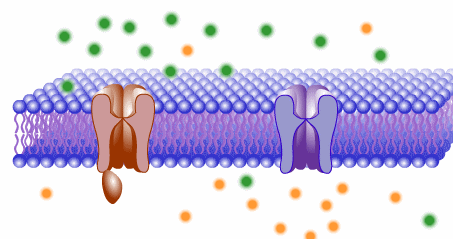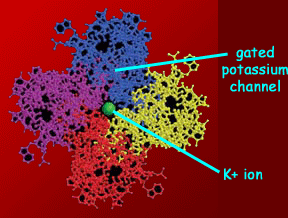
Submacroscopic Realities
Written 1995, revised 2011 by Steven Lewis
Korzybski devoted many pages in "Science and Sanity" to a discussion of events on the microscopic and submicroscopic levels. Some have been annoyed by these references, which they evaluate at least as unnecessary. From my perspective as a biology teacher, however, I can see quite clearly the signficance of Korzybski's references to these invisible levels.
Without science T.C. Mits will know only a macroscopic world. He will not be aware of the microscopic and submicroscopic levels. He will not be aware of cells, macromolecules (enzymes, receptors, membrane channels ...) and macromolecular assemblies (cell organelles, membranes ...), molecules, atoms etc. The problem with a macroscopic orientation is that the macroscopic level often hides changes within an organism as well as similarities and differences between organisms. When you are quietly meditating you may seem inactive, but on the microscopic and submicroscopic levels one is bustling with activity.
For the gross macroscopist (most people) it may seem magic that quantities of substances so tiny that they cannot be seen with the unaided eye can keep us alive or kill us if ingested. Nevertheless, a meager 2 micrograms of Vitamin B12 in our daily diet is all that most of us need to stay in good health, whereas a similar intake of a botulism toxin could kill a human. For a person with a submicroscopic perspective, however, the magic dissolves into the sciences of chemistry and colloidal behavior.

Gross macroscopists who look at a human and then at a spider will often be most skeptical that at one point we had a common ancestor. But with a submicroscopic orientation it becomes easier to accept that we share a common thread with a lowly spider ... that thread, of course, is DNA, a water-loving fibrous macromolecule. In fact, the spider's cells contain many of the same DNA instructions (genes) that are found in human cells. From the perspective of a submicroscopist we differ from a spider by the fact that we have a different sequence of nucleotides in our DNA. On the macroscopic level a human and a spider look as foreign to each other as a book in Japanese would look to an English speaker. However, on the submicroscopic level the spider and the human look like two different books but both written in the same language.
I tell my students that even if they forget most of the details of their chemistry studies, they can still benefit from their expanded awareness of events on the submicroscopic level. For them a 'world of neglected dimensions' has been opened up ... a part of the world most people don't even know exists.
When Korzybski referred to "events on the submicroscopic levels" he was not, for example, endorsing a particular theory of enzyme function or receptor activation or gene replication or atomic structure. Instead, he was reminding us of the importance of a dynamic submicroscopic orientation. His mission was to introduce his readers to a more diverse structural foundation to account for macroscopic functions and variations.
During the past half century we have learned much about structures on the microscopic and submicroscopic levels. On the colloidal levels we have determined the structure of biological membranes, how enzymes catalyze their reactions, how nerve cells release neurotransmitters and how these transmitters activate receptors at post-synaptic membranes .... We have learned how voltage-sensitive colloidal proteins enable conduction of electrical signals ("action potentials") along cell membranes by subtle changes in their structure ("conformation") that allow specific charges ("ions") to pass through the electrically-polarized membrane.


From a submicroscopic perspective we know today that an invisible dose of botulism toxin contains millions of proteins that bind to specific proteins at the neuro-muscular junction, preventing the release of the neurotransmitter acetylcholine, thereby preventing muscle contraction. The details of any particular interaction may be found in microbiology and toxicology textbooks, but are generally less important to the public than a general dynamic submacroscopic orientation.
Go to General Semantics Home Page ||| Go to Steven Lewis Home Page